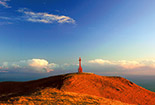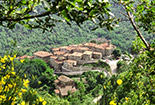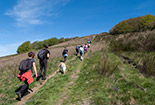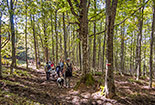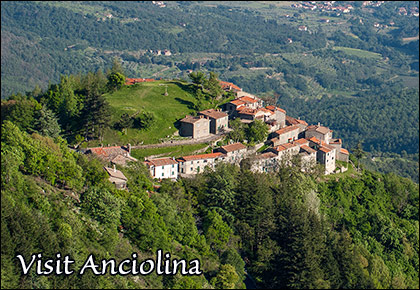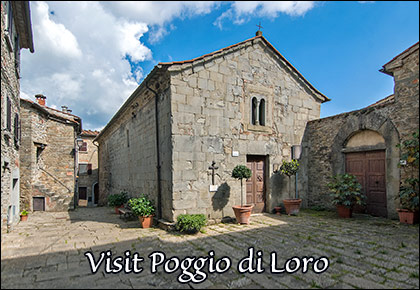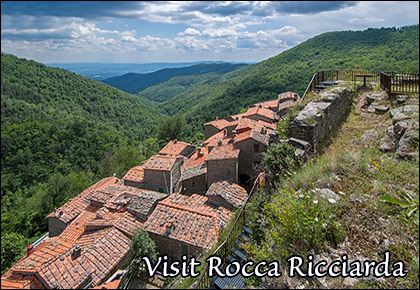From a Guidi castle to a Benedictine abbey
itinerary on the Pratomagno from Trappola to the Tre Punte, Santa Trinita and Bottigliana
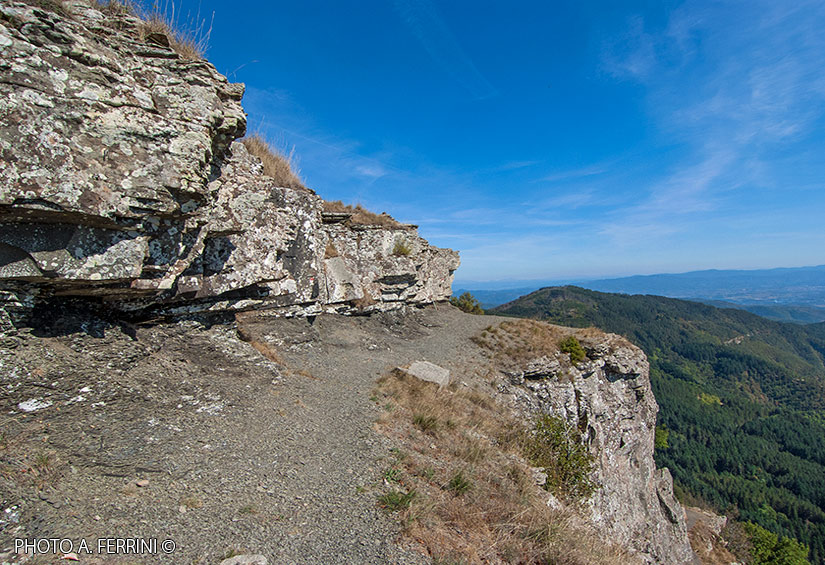
Texts and photos by Alessandro Ferrini ©
90 images in sequence to learn about this itinerary in Pratomagno. Click to start the virtual excursion
From Trappola, originally a Guidi castle, to the Santa Trinita Abbey
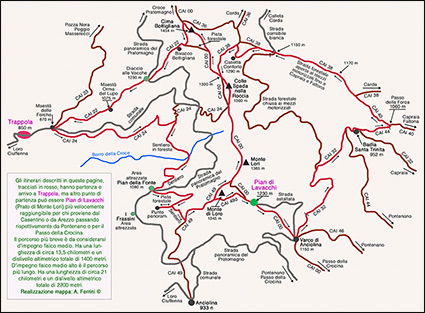 The trekking itinerary that we describe in this section offers us the possibility to choose between two lengths, 13.5 or 21 kilometres. The total altitude difference is 1400 or 2200 meters respectively. One criterion of choice is certainly the different physical commitment they entail, but it could also be what the two paths offer. With both itineraries we will walk among beautiful nature enjoying spectacular views, we will also encounter important historical situations such as Trappola, a mountain village in the municipality of Loro Ciuffenna which originated from a castle of the Guidi, Lords of the upper Casentino, on the Valdarno side of Pratomagno. With the longer route we will also descend onto the Casentino slopes of the mountain to visit the ruins of Santa Trinita (around 960), the first abbey built in an area today including the Casentino, the land of Arezzo and the Valdarno. The longest excursion may seem very demanding, but if undertaken in periods of the year when the days are quite long, with due calm and with the stops that the route invites us to make, the eight/nine hours that this walk involves will pass pleasantly. The starting and arrival point of this itinerary that we are about to describe in this text and in the ninety sequential pages is Trappola (850 meters above sea level), but it can also be Pian di Lavacchi, better known as the Monte Lori meadow, 1230 meters above sea level altitude. This place can be reached quicker for those arriving from the lower Casentino or Arezzo. Starting from Pian dei Lavacchi you can also choose to do just the route that descends on the Casentino side of the massif (about 12 kilometres), we recommend going anti-clockwise. Trappola is located on a rocky spur on the steep Valdarno slopes of Pratomagno which dominates the entire Upper Valdarno. Today the village has about ten permanent inhabitants, once there were several hundreds. Some historical information about the place is reported in the first six pages of the gallery. Three hundred meters above Trappola is the Maestà delle Forche, it is here that our journey begins on CAI 24, a dirt road on the right which is also suitable for vehicles because it serves a couple of houses that we come across after a few minutes. After the buildings, the route becomes a forest road and offers us beautiful views of the southern part of Pratomagno, it is up there that we will arrive. Then the CAI 24 enters a beautiful forest characterized by the presence of many fruit chestnut trees. After just over a kilometer we arrive at a crossroads where we have to keep right crossing a ditch. Here the road became steeper, but nothing challenging.
The trekking itinerary that we describe in this section offers us the possibility to choose between two lengths, 13.5 or 21 kilometres. The total altitude difference is 1400 or 2200 meters respectively. One criterion of choice is certainly the different physical commitment they entail, but it could also be what the two paths offer. With both itineraries we will walk among beautiful nature enjoying spectacular views, we will also encounter important historical situations such as Trappola, a mountain village in the municipality of Loro Ciuffenna which originated from a castle of the Guidi, Lords of the upper Casentino, on the Valdarno side of Pratomagno. With the longer route we will also descend onto the Casentino slopes of the mountain to visit the ruins of Santa Trinita (around 960), the first abbey built in an area today including the Casentino, the land of Arezzo and the Valdarno. The longest excursion may seem very demanding, but if undertaken in periods of the year when the days are quite long, with due calm and with the stops that the route invites us to make, the eight/nine hours that this walk involves will pass pleasantly. The starting and arrival point of this itinerary that we are about to describe in this text and in the ninety sequential pages is Trappola (850 meters above sea level), but it can also be Pian di Lavacchi, better known as the Monte Lori meadow, 1230 meters above sea level altitude. This place can be reached quicker for those arriving from the lower Casentino or Arezzo. Starting from Pian dei Lavacchi you can also choose to do just the route that descends on the Casentino side of the massif (about 12 kilometres), we recommend going anti-clockwise. Trappola is located on a rocky spur on the steep Valdarno slopes of Pratomagno which dominates the entire Upper Valdarno. Today the village has about ten permanent inhabitants, once there were several hundreds. Some historical information about the place is reported in the first six pages of the gallery. Three hundred meters above Trappola is the Maestà delle Forche, it is here that our journey begins on CAI 24, a dirt road on the right which is also suitable for vehicles because it serves a couple of houses that we come across after a few minutes. After the buildings, the route becomes a forest road and offers us beautiful views of the southern part of Pratomagno, it is up there that we will arrive. Then the CAI 24 enters a beautiful forest characterized by the presence of many fruit chestnut trees. After just over a kilometer we arrive at a crossroads where we have to keep right crossing a ditch. Here the road became steeper, but nothing challenging. 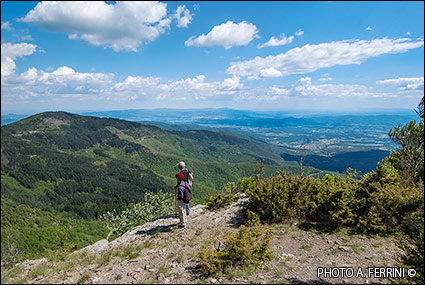 A few more hundred meters and the CAI 24 turns left, turning into a path that climbs quite steeply, we continue to the right on the forest road which ends shortly after. The path, on the right, which replaces the road we could define as the "wildest" kilometer of this itinerary. Nothing dangerous, but we have to pay a little more attention, especially if the ground is wet. Between ups and downs in a mixed forest, we reach the crossing of a ditch. After this, with a very short climb we reach a small plateau where there is a table and a bench. Here a forest track starts again among the beech trees which in a few minutes leads us to a crossroads where we will continue left up a steep climb. A sign indicates that there are 900 meters to go to Pian della Fonte, a beautiful equipped area along the Pratomagno panoramic road. We continue walking on a forest track used for logging, at a certain point we arrive at a sort of crossroads, we have to go right. It is clear from the name that there is no shortage of water in Pian della Fonte, nor tables to sit at and refresh yourself after these first five kilometers of walking. We now have 1.5 kilometers of climbing ahead of us to reach the spectacular Le Tre Punte cliff. Having crossed the panoramic road, we take the forest track which continues to take us up into a lush beech forest. At a certain point the forest ends and the forest track becomes a path. In a few meters we arrive at a crossroads on a grassy clearing. Our route turns left, going up, but if we don't mind extending the hike by a few hundred metres, we continue straight on on the flat path that enters a large meadow. At the end of this flat area there is a bench. From here we can enjoy a beautiful panorama of the Upper Valdarno beyond which there are the mountains that separate this land from that of Chianti. Let's go back, the highest peak we see in front of us is Monte di Loro, we will soon be up there. This time, at the crossroads, we take the path that goes up, to our right. Initially we continue walking in the clearing, then we return to the woods and after about ten minutes of continuous, non-demanding climb we reach the intersection with CAI 49 which, on the right, descends to Anciolina. We have to go left, but first we continue straight for a few meters. We will find ourselves in a fantastic panoramic point from where we will be able to observe the spectacular cliff which, shortly, we will pass over. We start walking on the CAI 49 which runs on the crest of a sort of spur of the Pratomagno which descends towards the Valdarno. Going up slightly, the path takes us to a small hill without plants from where we can observe the large massif up to the famous cross. A few more minutes of walking and the CAI 49 doubles. Our itinerary involves going right, going up.
A few more hundred meters and the CAI 24 turns left, turning into a path that climbs quite steeply, we continue to the right on the forest road which ends shortly after. The path, on the right, which replaces the road we could define as the "wildest" kilometer of this itinerary. Nothing dangerous, but we have to pay a little more attention, especially if the ground is wet. Between ups and downs in a mixed forest, we reach the crossing of a ditch. After this, with a very short climb we reach a small plateau where there is a table and a bench. Here a forest track starts again among the beech trees which in a few minutes leads us to a crossroads where we will continue left up a steep climb. A sign indicates that there are 900 meters to go to Pian della Fonte, a beautiful equipped area along the Pratomagno panoramic road. We continue walking on a forest track used for logging, at a certain point we arrive at a sort of crossroads, we have to go right. It is clear from the name that there is no shortage of water in Pian della Fonte, nor tables to sit at and refresh yourself after these first five kilometers of walking. We now have 1.5 kilometers of climbing ahead of us to reach the spectacular Le Tre Punte cliff. Having crossed the panoramic road, we take the forest track which continues to take us up into a lush beech forest. At a certain point the forest ends and the forest track becomes a path. In a few meters we arrive at a crossroads on a grassy clearing. Our route turns left, going up, but if we don't mind extending the hike by a few hundred metres, we continue straight on on the flat path that enters a large meadow. At the end of this flat area there is a bench. From here we can enjoy a beautiful panorama of the Upper Valdarno beyond which there are the mountains that separate this land from that of Chianti. Let's go back, the highest peak we see in front of us is Monte di Loro, we will soon be up there. This time, at the crossroads, we take the path that goes up, to our right. Initially we continue walking in the clearing, then we return to the woods and after about ten minutes of continuous, non-demanding climb we reach the intersection with CAI 49 which, on the right, descends to Anciolina. We have to go left, but first we continue straight for a few meters. We will find ourselves in a fantastic panoramic point from where we will be able to observe the spectacular cliff which, shortly, we will pass over. We start walking on the CAI 49 which runs on the crest of a sort of spur of the Pratomagno which descends towards the Valdarno. Going up slightly, the path takes us to a small hill without plants from where we can observe the large massif up to the famous cross. A few more minutes of walking and the CAI 49 doubles. Our itinerary involves going right, going up. 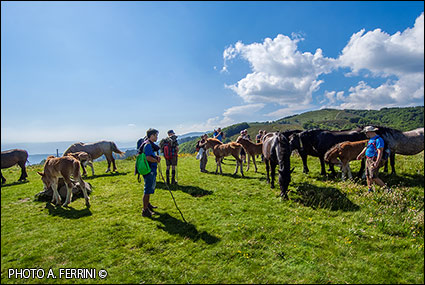 After about twenty meters we are at the beginning of the Le Tre Punte cliff which we can walk along enjoying the beauty of the rocks and a breathtaking view. Below us we see the village of Anciolina located on the top of a hill. Due to its position it was a much disputed castle in medieval times. The large town in the valley bottom is San Giustino Valdarno, while in the background we see Arezzo. If there is no mist, just to the right of the city, we can make out Lake Trasimeno in the distance. A little further to the right, the horizon is marked by Monte Amiata, unmistakable for its double peak, and Monte Cetona, with its pointed shape. On the cliffs the CAI section of Arezzo has created a via ferrata, named after Romana Nesi, with several climbs of different degrees of difficulty. The passage over the cliffs requires a little attention, but is not considered dangerous. It may bother someone who suffers from vertigo. In this case, where CAI 49 splits, we recommend taking the path on the left that runs through the woods. The two paths meet at the end of the cliff, from here, in a few minutes, we reach a crossroads. On the right the CAI 49 D begins which descends towards Pian dei Lavacchi, it is also the beginning of the long variant of the itinerary which we will describe later. Now we continue to the right on CAI 49 (short 13.5 kilometer variant) which runs on the northern side of Monte di Loro, a short distance from the summit, inside a beautiful forest. In five minutes we reach the junction with the CAI 00 ridge which we take, going up. After two hundred meters we are on Monte Lori from which we have a view of Pratomagno up to the famous cross and its Valdarno slopes. From this peak a descent of about 1.5 kilometers begins, a very pleasant stretch especially in spring when the clearings along the route are covered with many varieties of flowers. Due to the vegetation present, in this stretch we do not have particular views. We also cross a lush beech forest, at the end of which we find a detour to the left. It is the CAI 24 on which we started the excursion. A few meters after the intersection, CAI 00 continues flat, to the left. We go right to go up to the Sword in the Stone. This hill is the most spectacular in Pratomagno from the point of view of spring blooms. In particular around May 20th when it is covered with a carpet of daffodils. At the Spada nella Roccia we return to enjoy a beautiful view, in front of us we have the Cima Bottigliana which we have to reach. Then, let's get back on the road on the short descent that runs on a pleasant, rich grassy surface. In the saddle between the Spada nella Roccia and Bottigliana hills, CAI 38 comes from the right, it is the route that will lead us to this point if we choose to try the longer excursion, from here both itineraries follow the same route. After an initial climb towards Cima Bottigliana we find a flat stretch at the end of which there is a crossroads. Going left we take a flat forest road, we continue right on CAI 00 which takes us up to Cima Bottigliana. From up here we will have a view of that part of Pratomagno on which we have just walked, towards the north-east we will be able to observe the massif up to the large cross.
After about twenty meters we are at the beginning of the Le Tre Punte cliff which we can walk along enjoying the beauty of the rocks and a breathtaking view. Below us we see the village of Anciolina located on the top of a hill. Due to its position it was a much disputed castle in medieval times. The large town in the valley bottom is San Giustino Valdarno, while in the background we see Arezzo. If there is no mist, just to the right of the city, we can make out Lake Trasimeno in the distance. A little further to the right, the horizon is marked by Monte Amiata, unmistakable for its double peak, and Monte Cetona, with its pointed shape. On the cliffs the CAI section of Arezzo has created a via ferrata, named after Romana Nesi, with several climbs of different degrees of difficulty. The passage over the cliffs requires a little attention, but is not considered dangerous. It may bother someone who suffers from vertigo. In this case, where CAI 49 splits, we recommend taking the path on the left that runs through the woods. The two paths meet at the end of the cliff, from here, in a few minutes, we reach a crossroads. On the right the CAI 49 D begins which descends towards Pian dei Lavacchi, it is also the beginning of the long variant of the itinerary which we will describe later. Now we continue to the right on CAI 49 (short 13.5 kilometer variant) which runs on the northern side of Monte di Loro, a short distance from the summit, inside a beautiful forest. In five minutes we reach the junction with the CAI 00 ridge which we take, going up. After two hundred meters we are on Monte Lori from which we have a view of Pratomagno up to the famous cross and its Valdarno slopes. From this peak a descent of about 1.5 kilometers begins, a very pleasant stretch especially in spring when the clearings along the route are covered with many varieties of flowers. Due to the vegetation present, in this stretch we do not have particular views. We also cross a lush beech forest, at the end of which we find a detour to the left. It is the CAI 24 on which we started the excursion. A few meters after the intersection, CAI 00 continues flat, to the left. We go right to go up to the Sword in the Stone. This hill is the most spectacular in Pratomagno from the point of view of spring blooms. In particular around May 20th when it is covered with a carpet of daffodils. At the Spada nella Roccia we return to enjoy a beautiful view, in front of us we have the Cima Bottigliana which we have to reach. Then, let's get back on the road on the short descent that runs on a pleasant, rich grassy surface. In the saddle between the Spada nella Roccia and Bottigliana hills, CAI 38 comes from the right, it is the route that will lead us to this point if we choose to try the longer excursion, from here both itineraries follow the same route. After an initial climb towards Cima Bottigliana we find a flat stretch at the end of which there is a crossroads. Going left we take a flat forest road, we continue right on CAI 00 which takes us up to Cima Bottigliana. From up here we will have a view of that part of Pratomagno on which we have just walked, towards the north-east we will be able to observe the massif up to the large cross. 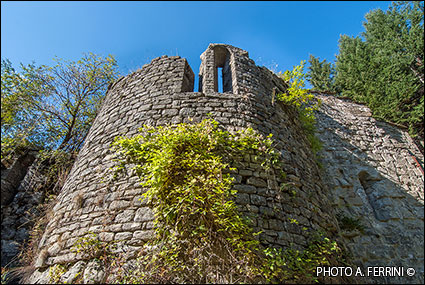 Continuing to follow the CAI 00, in two hundred meters of pleasant descent we arrive at a saddle where, from the left, the CAI 22 arrives which we will have to follow for the return to Trappola. After four hundred meters of descent into the meadow, the route reaches the border between meadow and woods where it meets the forest road that we found when climbing the Bottigliana. We turn right and after a few dozen meters left. Going down, we enter a beautiful beech forest. In two hundred meters we reach the Bivacco Bottigliana, a structure also equipped with services because it was rebuilt in the years 2021 - 2022 on the ruins of the Casetta Bottigliana which was a refuge for those woodcutters, shepherds and charcoal burners who worked in this area. Before continuing the descent on CAI 22, we can take a short "off-piste" trip to see the "Shepherd's Cave", a large and very particular boulder. It is described in these pages. CAI 22 follows a historic mule track and in several sections still shows the ancient pavement. From the bivouac in about a kilometer we arrive at the Pratomagno panoramic road and after crossing it we continue on the same route. In another kilometer we reach the Maestà dell'Orma del Lupo, a small building that a legend links to San Francesco. You can read it on page 59 of the sequence. We continue to descend on CAI 22 where the paved sections are more frequent and evident. In about eight hundred meters we arrive at the Maestà delle Forche, the starting point of this excursion. Now let's describe the stretch of route of about ten kilometers we will find ourselves walking if we decide to try our hand at the longer itinerary. At the crossroads we encounter after passing the Le Tre Punte cliff, this time we leave CAI 49 to continue, on the right, on CAI 49 D which in eight hundred meters takes us down to the large meadow of Pian di Lavacchi. In the first stretch the path runs through a clearing on the southern side of Monte di Loro. We still have a beautiful view because we continue walking on the top of a cliff, but not close to the precipice, so the route does not cause problems even for those who suffer from vertigo. Then we enter a lush beech forest. In a few minutes we arrive at the intersection with CAI 00 which we will take on the right. After two hundred meters we are in Pian di Lavacchi, a reference point for families with children because it is easy to reach by car from Arezzo, the lower Casentino and Valdarno. It is also the starting point for the most classic walk of Pratomagno: from here to the cross and back, always keeping to the ridge, about seventeen kilometres. Having crossed Pian di Lavacchi, continuing the journey on CAI 00, we climb the next hill which we then descend. A stretch of about a kilometer that takes us to the asphalt road, on which we will walk for about a hundred metres.
Continuing to follow the CAI 00, in two hundred meters of pleasant descent we arrive at a saddle where, from the left, the CAI 22 arrives which we will have to follow for the return to Trappola. After four hundred meters of descent into the meadow, the route reaches the border between meadow and woods where it meets the forest road that we found when climbing the Bottigliana. We turn right and after a few dozen meters left. Going down, we enter a beautiful beech forest. In two hundred meters we reach the Bivacco Bottigliana, a structure also equipped with services because it was rebuilt in the years 2021 - 2022 on the ruins of the Casetta Bottigliana which was a refuge for those woodcutters, shepherds and charcoal burners who worked in this area. Before continuing the descent on CAI 22, we can take a short "off-piste" trip to see the "Shepherd's Cave", a large and very particular boulder. It is described in these pages. CAI 22 follows a historic mule track and in several sections still shows the ancient pavement. From the bivouac in about a kilometer we arrive at the Pratomagno panoramic road and after crossing it we continue on the same route. In another kilometer we reach the Maestà dell'Orma del Lupo, a small building that a legend links to San Francesco. You can read it on page 59 of the sequence. We continue to descend on CAI 22 where the paved sections are more frequent and evident. In about eight hundred meters we arrive at the Maestà delle Forche, the starting point of this excursion. Now let's describe the stretch of route of about ten kilometers we will find ourselves walking if we decide to try our hand at the longer itinerary. At the crossroads we encounter after passing the Le Tre Punte cliff, this time we leave CAI 49 to continue, on the right, on CAI 49 D which in eight hundred meters takes us down to the large meadow of Pian di Lavacchi. In the first stretch the path runs through a clearing on the southern side of Monte di Loro. We still have a beautiful view because we continue walking on the top of a cliff, but not close to the precipice, so the route does not cause problems even for those who suffer from vertigo. Then we enter a lush beech forest. In a few minutes we arrive at the intersection with CAI 00 which we will take on the right. After two hundred meters we are in Pian di Lavacchi, a reference point for families with children because it is easy to reach by car from Arezzo, the lower Casentino and Valdarno. It is also the starting point for the most classic walk of Pratomagno: from here to the cross and back, always keeping to the ridge, about seventeen kilometres. Having crossed Pian di Lavacchi, continuing the journey on CAI 00, we climb the next hill which we then descend. A stretch of about a kilometer that takes us to the asphalt road, on which we will walk for about a hundred metres. 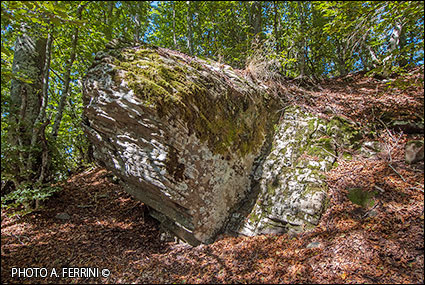 To the left of this there is a large clearing used as a lumber yard. We are in the most important historical pass in the southern part of Pratomagno: the Anciolina pass. It is very likely that an ancient route crossed the mountain here: the Via Abversa. We talk about this road on pages 69 and 70 of the sequence. From this pass the CAI 00 continues and with a short climb reaches Poggio della Cesta, then descends to the Crocina Pass. We go left, following the CAI 36, a road that in a few hundred meters reaches the Fonte dello Squarto campsite and then continues towards Badia Santa Trinita (three kilometers). Shortly after, the campsite is closed to the transit of motorized vehicles. Beyond the barrier, CAI 36 becomes a forest road and is almost flat in the first five hundred metres. In this stretch we have a broad panorama towards the south-east. Then a constant descent begins until a deviation to the right that we must follow (we are two kilometers from the Anciolina pass). Up to this point, beech trees have mainly accompanied our journey, from the crossroads we also begin to find fir trees, then, as we approach Santa Trinita, the presence of chestnut trees will be increasingly greater, plants which through their fruits were once synonymous with bread. At the bottom of the descent we find a small bridge that takes us across the Fosso della Badia. A few meters earlier, coming from the right, the CAI 44 which comes from Pontenano, another route of historical importance since the 11th century, overlapped our route. With a climb of a hundred meters inside a thick fir tree, the CAI 32 and 44, overlapping, take us in front of the fascinating ruins of Santa Trinita in Alpe and other houses built in the last decades of the nineteenth century. Even if the abbey is really in bad shape, we will be struck by great amazement. The entire plan of the church is clearly distinguishable, so we realize how big it was. The first thought that comes to mind is how such a large religious complex could have been built in such an isolated place around 960. The answer to this question and other historical information about the abbey can be found on pages 74 and 75 of the sequence. After a necessary stop to admire and be moved by this place (there are also benches and tables for resting and refreshment in comfort) we continue our journey, taking the abbey behind us. At the source, CAI 32 and 44 split up. The first one turns right to head towards Capraia, we continue on the second which continues straight for a few meters and then begins to climb quite steeply. In about seven hundred metres, from 952 meters of Badia Santa Trinità we will arrive at 1060 meters of Passo della Forca where we join the CAI 40 which on the right heads towards Faltona, we go in the opposite direction. This route is an open forest road, so it is possible to get up here from Castelnuovo di Faltona or from Calleta with a suitable vehicle. The CAI 40 immediately begins to rise, but not in a serious way. After three hundred metres, from a wide bend to the right where the road surface has been cemented, we have a beautiful view towards the south, without haze we dominate the city of Arezzo and the surrounding area.
To the left of this there is a large clearing used as a lumber yard. We are in the most important historical pass in the southern part of Pratomagno: the Anciolina pass. It is very likely that an ancient route crossed the mountain here: the Via Abversa. We talk about this road on pages 69 and 70 of the sequence. From this pass the CAI 00 continues and with a short climb reaches Poggio della Cesta, then descends to the Crocina Pass. We go left, following the CAI 36, a road that in a few hundred meters reaches the Fonte dello Squarto campsite and then continues towards Badia Santa Trinita (three kilometers). Shortly after, the campsite is closed to the transit of motorized vehicles. Beyond the barrier, CAI 36 becomes a forest road and is almost flat in the first five hundred metres. In this stretch we have a broad panorama towards the south-east. Then a constant descent begins until a deviation to the right that we must follow (we are two kilometers from the Anciolina pass). Up to this point, beech trees have mainly accompanied our journey, from the crossroads we also begin to find fir trees, then, as we approach Santa Trinita, the presence of chestnut trees will be increasingly greater, plants which through their fruits were once synonymous with bread. At the bottom of the descent we find a small bridge that takes us across the Fosso della Badia. A few meters earlier, coming from the right, the CAI 44 which comes from Pontenano, another route of historical importance since the 11th century, overlapped our route. With a climb of a hundred meters inside a thick fir tree, the CAI 32 and 44, overlapping, take us in front of the fascinating ruins of Santa Trinita in Alpe and other houses built in the last decades of the nineteenth century. Even if the abbey is really in bad shape, we will be struck by great amazement. The entire plan of the church is clearly distinguishable, so we realize how big it was. The first thought that comes to mind is how such a large religious complex could have been built in such an isolated place around 960. The answer to this question and other historical information about the abbey can be found on pages 74 and 75 of the sequence. After a necessary stop to admire and be moved by this place (there are also benches and tables for resting and refreshment in comfort) we continue our journey, taking the abbey behind us. At the source, CAI 32 and 44 split up. The first one turns right to head towards Capraia, we continue on the second which continues straight for a few meters and then begins to climb quite steeply. In about seven hundred metres, from 952 meters of Badia Santa Trinità we will arrive at 1060 meters of Passo della Forca where we join the CAI 40 which on the right heads towards Faltona, we go in the opposite direction. This route is an open forest road, so it is possible to get up here from Castelnuovo di Faltona or from Calleta with a suitable vehicle. The CAI 40 immediately begins to rise, but not in a serious way. After three hundred metres, from a wide bend to the right where the road surface has been cemented, we have a beautiful view towards the south, without haze we dominate the city of Arezzo and the surrounding area. 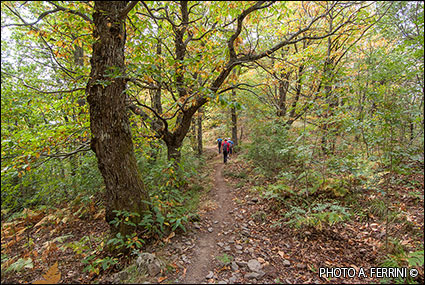 Eight hundred meters from Passo della Forca, CAI 40 ends, giving way to CAI 38 which climbed up here from Carda. We, continuing to walk straight on the ridge without noticing this change. Alternating panoramic stretches with others inside the woods, in 1.5 kilometers we arrive at a crossroads. The road on the right goes down to Calleta, the one on the left, closed by a barrier, leads to the Varco di Anciolina. It is the one we followed for two kilometers (CAI 36). We continue straight on CAI 38 which from here begins to climb rather steeply. After about four hundred meters, being careful, we see a deviation to the left. It is a forest track which in another four hundred metres, almost flatly, leads us to the Casetta del Conforto bivouac. Here there is also a beautiful and comfortable equipped area. If we need water, we find it inside the bivouac. From here, a slightly uphill forest track through a beautiful forest takes us back to CAI 38 which, three hundred meters beyond the deviation where we left it, at a gate, turned left to head towards the Pratomagno ridge, this is the direction we are preparing to follow. In about eight hundred metres, CAI 38 takes us to CAI 00 on the crest of the massif, in the saddle between the Spada nella Roccia hill and Cima Bottigliana which we have already virtually passed by describing the shortest itinerary. We turn right and start climbing towards Bottigliana, we have already described this route to return to Trappola previously and is shown from page 46 to page 61.
Eight hundred meters from Passo della Forca, CAI 40 ends, giving way to CAI 38 which climbed up here from Carda. We, continuing to walk straight on the ridge without noticing this change. Alternating panoramic stretches with others inside the woods, in 1.5 kilometers we arrive at a crossroads. The road on the right goes down to Calleta, the one on the left, closed by a barrier, leads to the Varco di Anciolina. It is the one we followed for two kilometers (CAI 36). We continue straight on CAI 38 which from here begins to climb rather steeply. After about four hundred meters, being careful, we see a deviation to the left. It is a forest track which in another four hundred metres, almost flatly, leads us to the Casetta del Conforto bivouac. Here there is also a beautiful and comfortable equipped area. If we need water, we find it inside the bivouac. From here, a slightly uphill forest track through a beautiful forest takes us back to CAI 38 which, three hundred meters beyond the deviation where we left it, at a gate, turned left to head towards the Pratomagno ridge, this is the direction we are preparing to follow. In about eight hundred metres, CAI 38 takes us to CAI 00 on the crest of the massif, in the saddle between the Spada nella Roccia hill and Cima Bottigliana which we have already virtually passed by describing the shortest itinerary. We turn right and start climbing towards Bottigliana, we have already described this route to return to Trappola previously and is shown from page 46 to page 61.



